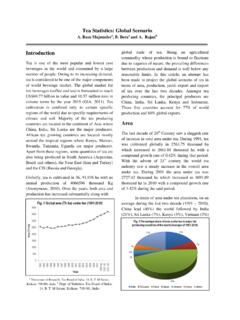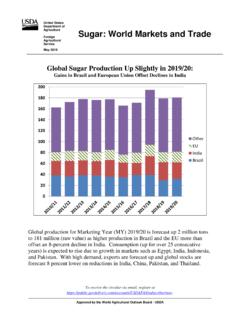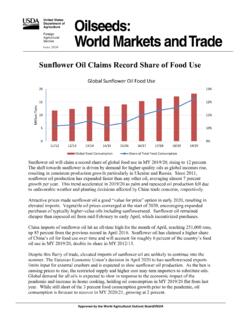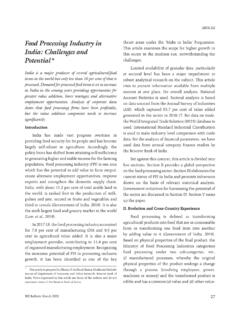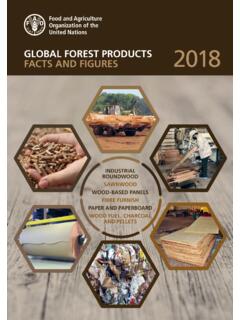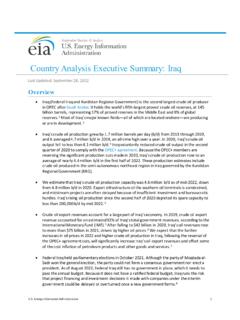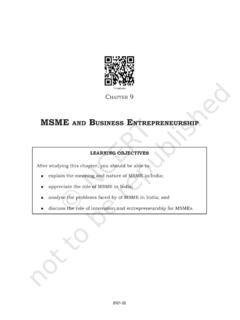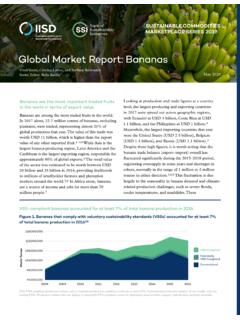Transcription of TRADE BETWEEN DEVELOPED AND DEVELOPING …
1 TRADE BETWEEN DEVELOPED AND DEVELOPING COUNTRIES': THE DECADE AHEAD Bela Balassa CONTENTS Introduction .. 8 1. TRADE policies and interdependence through TRADE in manufactured goods .. TRADE policies of DEVELOPED countries TRADE policies of DEVELOPING countries TRADE in manufactured goods BETWEEN DEVELOPED and DEVELOPING countries .. 13 .. 8 8 11 11. Multilateral TRADE liberalisation and the interests of DEVELOPED and DEVELOPING countries .. 16 TRADE liberalisation in DEVELOPING countries and DEVELOPED country interests .. 16 TRADE liberalisation in DEVELOPED countries and DEVELOPING country interests .. 19 TRADE negotiations BETWEEN the DEVELOPED countries and the newly- industrialising DEVELOPING countries .. 20 111. Modalities for North-South TRADE negotiations .. 2 1 The content of the negotiations .. 22 The adjustment problem .. 23 Concluding remarks .. 24 Bibliography .. 25 Steps towards a North-South round of TRADE negotiations.
2 , .. 21 This paper was prepared as part of a consultancy for the OECD by Bela Balassa, Professor of Political Economy at the Johns Hopkins University and Consultant to the World Bank. The opinions expressed herein are those of the author and should not be interpreted to reflect the views of the World Bank, the OECD, or its Member Governments. The author is grateful for helpful comments on the initial draft of the paper by participants at a seminar held at the OECD and by Costas Michalopoulos of the World Bank. 7 INTRODUCTION TRADE BETWEEN DEVELOPED and DEVELOPING countries, and the TRADE policies of the two groups of countries, are matters of considerable interest. It has been suggested, for example, that this TRADE should have a central role in any "new round" of GATT negotiations. Yet, it is difficult to find a comprehenseive statement of what the interests of DEVELOPED and DEVELOPING countries in TRADE liberalisation actually are.
3 This paper aims to define the interests of the DEVELOPED and DEVELOPING countries in the liberalisation of their mutual TRADE . Possible approaches to harnessing these interests for promoting North-South TRADE in the decade ahead will also be analysed. The context for the discussion is the TRADE policies of DEVELOPED and DEVELOPING countries in the postwar period. 1. TRADE POLICIES AND INTERDEPENDENCE THROUGH TRADE IN MANUFACTURED GOODS TRADE policies of DEVELOPED countries In the years following the Second World War, the DEVELOPED countries reduced their tariffs in the framework of successive rounds of TRADE negotiations on an item-by-item basis. The negotiations involved a compromise BETWEEN the principles of reciprocity and of nondiscrimination. With the DEVELOPING countries offering few tariff concessions, the DEVELOPED countries exchanged such concessions on products of interest to them. The DEVELOPING countries nevertheless benefitted from the tariff reductions that were made under the most-favoured-nation clause.
4 By the early 1960s' tariffs on manufactured goods imported from the DEVELOPING countries had declined to a considerable extent, although remaining higher than the DEVELOPED countries' overall tariff average on manufactured goods. (Balassa 1965, Table 2). At the same time, these tariffs showed a tendency towards escalation from lower to higher levels of fabrication, thereby discriminating against processing activities in the DEVELOPING countries. 8 In the framework of the Kennedy and the Tokyo rounds of negotiations, tariffs have been reduced substantially across the board, with exceptions made for sensitive items that have included products of interest to DEVELOPED (steel) as well as to DEVELOPING countries (textiles). As tariff reductions have again been smaller on manufactured goods imported from the DEVELOPING countries, post-Tokyo round tariffs on such goods remain somewhat higher than the overall average. The relevant figures are 9 and 7 per cent in the United States, 7 and 6 per cent in the European Economic Community, and 7 and 5 per cent in Japan'.
5 There is also a greater frequency of relatively high tariffs on the DEVELOPED countries' imports from the DEVELOPING countries than on their overall manufactured imports. Thus, in the United States, tariffs of 10 per cent or higher apply to 20 per cent of imports from DEVELOPING countries and 9 per cent of overall manufactured imports; comparable figures are 12 and 6 per cent for the EEC and 18 and 13 per cent for Japan. (Cline, 1984; Table ). Furthermore, although the extent of tariff escalation has been reduced, processing activities in the DEVELOPING countries continue to suffer discrimination as tariffs are generally nil on unprocessed goods but rise with the degree of fabrication on processed goods. Since the effective rate of tariff on the output exceeds the nominal rate whenever the latter is higher than the tariff on the inputs, relatively low output tariffs may give rise to high effective rates of protection on the processing activity.
6 Much has been said in recent years about the proliferation of import restrictions that represent non-tariff barriers to TRADE in the DEVELOPED countries. The long recession of the years 1980-82 has in fact led to the imposition of some protectionist measures in the United States and in the European Economic Community. However, the pervasive restrictions and the international cartels of the 1930s have not been repeated. Also, the ire of protectionists has been largely directed against other DEVELOPED countries and, apart from some tightening of the Multifiber Arrangement, few measures have been taken against DEVELOPING countries during the recession. At the same time, in the United States, quantitative restrictions on footwear originating in DEVELOPING countries have been abolished. (Balassa and Balassa 1 984). Thus, the deceleration of the growth of manufactured imports from the DEVELOPING countries can be attributed to the decline in GNP growth rates in the DEVELOPED countries rather than to increased protection.
7 In fact, the apparent income elasticity of demand for manufactured goods imported from the DEVELOPING countries (the ratio of the rate of growth of these imports to that of GNP) continued to increase (Table Similar conclusions are reached if one considers the share of imports from the DEVELOPING countries in the apparent consumption of manufactured goods ( production plus imports minus exports) in the DEVELOPED countries. This ratio increased from per cent in 1973 to per cent in 1 , and again to per 9 Table 1. Changes in the volume of TRADE in manufactured goods BETWEEN DEVELOPED and eveloping countries, related to changes in GNPa Industrial countries 1963-73 1973-78 1978-81 1973-81 DEVELOPING countries 1963-73 1973-78 1978-81 1973-81 Oil-importing DEVELOPING countries 1973-78 1978-81 1973-81 Average annual rate of growth Imports GNP Oil-exporting DEVELOPING countries 1973-78 1978-81 1973-81 a) This table contains revised GNP growth rates for the DEVELOPING countries.
8 Apparent income elasticityb 6) The apparent income elasticity has been calculated with respect to GNP. rather than national income. Where terms of TRADE changes have been important, as for the oil-exporting countries in particular, these two measures can diverge substantially. Bela Balassa, "Trends in International TRADE in Manufactured Goods and Structural Change in the Industrial Countries," invited paper prepared for the 7th World Congress of the International Economic Association on Structural Change, Economic Interdependence, and World Development, held in Madrid, Spain on September 5- 9, 1983. Source: cent in 198 1, with incremental shares (the ratio of increases in imports to increases in apparent consumption ) rising from per cent in 1973-78 to per cent in 1978-8 1 (Table 2). Notwithstanding some tightening of the Multifiber Arrangement, the devel- oping countries also succeeded in raising their share in DEVELOPED country markets for textiles and clothing.
9 This result indicates the success of the DEVELOPING countries in circumventing the restrictions imposed by the DEVELOPED countries on textiles and clothing. This has occurred through upgrading as well as through the shift of exports to products, and the shift of the place of production to countries which are not subject to restrictions. More generally, while the expansion of exports has been constrained by existing import restrictions as well as by the threat of the imposition of restrictions, the process of diversification in the DEVELOPING countries has permitted them to 10 increase their shares in DEVELOPED country markets for manufactured goods in an unfavourable world environment. Thus, the success of the DEVELOPING countries in exploiting the possibilities available in DEVELOPED country markets has been determined to a great extent by the policies applied by the DEVELOPING countries themselves. The policies followed by the DEVELOPING countries have also affected their ability to export primary commodities.
10 But DEVELOPED country policies have also had important effects. Foods produced in DEVELOPING countries which compare with domestic production in the DEVELOPED countries encounter barriers in these countries and often have to compete with their subsidised exports. The Common Agricultural Policy of the EEC as well as Japanese restrictions affect, in particular, sugar, cereals, vegetable oils and oilseed, beef and veal, wine, and tobacco; while the United States limits the importation of sugar and, to a lesser extent, oilseeds. It has been estimated that a 50 per cent reduction in the DEVELOPED countries' TRADE barriers on foods would lead to an 1 1 per cent increase in the exports of these commodities from the DEVELOPING countries. (Valdez and Zietz, 1980). This figure understates, however, the impact of the DEVELOPED countries' agricultural policies on DEVELOPING country food exports by excluding the effects of export subsidies.











